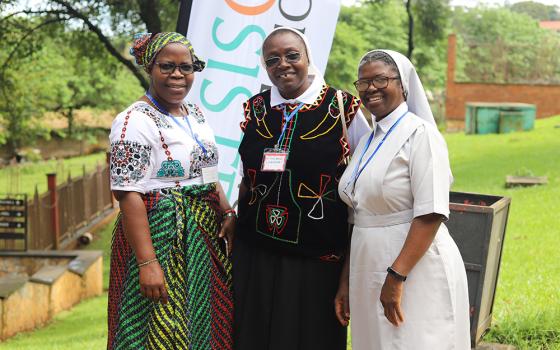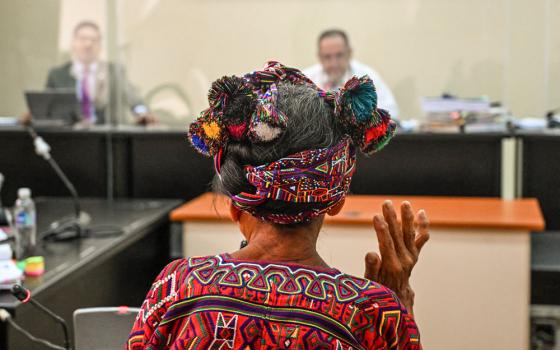
As we drove the final few feet toward the retreat center, the sound of banjo playing pulled me out of the car. I was drawn toward the sound as if some primal instinct was reawakening.
The band was playing a dancing tune. And the people huddling in the relatively dry area under the awning outside on a cold, wet Midwestern fall day weren’t wasting the opportunity to dance.
Someone in the distance was calling instructions: “Swing your partner, round and round.” Dozens of people -- most under the age of 25 or so -- were gleefully following with as much precision as a few drinks of alcohol would allow.
People were bumping into each other, laughing at their clumsiness and embracing the silliness of spending time outside listening to a few string instruments as the rain pattered on the tin roof above.
Before I knew it, I was circling around with everyone else, laughing as I bounced and bumped with the crowd.
Just like that I had become a part of this year’s gathering of Midwestern Catholic Workers.
The people dancing had come from a dozen states and nearly three dozen Catholic Worker communities. They had driven across the country for an annual weekend of happy rest at the Sugar Creek Retreat Center in Preston, Iowa, Sept. 17-19. For two and a half days they would meet, share stories and dance together.
The history of the gathering is storied. Some decades back a few Catholic Worker communities decided to meet to take rest from their busy ministries. Over the years the gathering has changed -- and the number of people has grown from a few to over 200 -- but the focus has always been to simply have fun.
Despite their vocal opposition to a society that seems to be continually on fast-forward, Catholic Workers can be a tired bunch. A sampling of the different ministries of those at the gathering shows why.
One community, near a state penitentiary, offers rooms for prison visitors; another houses women who are homeless; a third opens its doors daily to provide food for over 200 people.
The history of the movement provides the impetus. Dorothy Day opened the first Catholic Worker house with Peter Maurin in New York City in 1933.
Day and Maurin wanted to live out the works of mercy. They opened their doors and offered food, company and a kind ear to those that stopped in. Trusting in grace, everything they had was donated and given freely to those in need.
Ever since, Catholic Worker houses have sprung up across the world. They try to live out the Gospel by following it -- by giving the hungry something to eat, the thirsty something to drink.
At Sugar Creek, it’s a time to leave behind figuring out where all that food and drink will come from. It’s a time to dance.
It’s also a time to share.
On the second day of the weekend, everyone gathered for introductions. They filled a dank basement room, making a large circle. As it rained outside -- splashes of water making it through the open windows -- they compared notes on what it’s like to live a life of precariousness and voluntary poverty.
One community -- the Mustard Seed Farm in Ames, Iowa -- shared how they’ve been living in a friend’s house while theirs was under construction. They had just finished installing a roof.
Alice McGary, founder of the farm and one of a dozen people associated with it, talked about the fullness of life on the land -- a mix of dealing with the cycles of planting and harvesting, organizing a community-supported agriculture model to sell their crops, and building a new home.
McGary’s final words to the group summed up the work ahead. She said tentatively, “Well, I think we’ll be OK.”
Those simple words reflected a sincere belief among those gathered in the incredible bounty of providence -- that those who live the Gospel will find themselves cared for, by God and each other.
At the end of her book The Long Loneliness, Day wrote of how, as her community began its ministry to the impoverished of New York, they somehow found what they needed to survive.
Relating how they were always mysteriously able to accommodate people who needed a place to stay, Day wrote: “We were just sitting there talking and people moved in on us. ... Some moved out and that made room for more. And somehow the walls expanded.”
As we walked out of the basement room that day, I looked back out at the awning outside. It was raining again, but people were out sitting under the tin roof, talking and sharing the various ways they try to live the Gospel by providing for those in need.
As I looked out, I saw a vision of the church alive. A church that finds its life in living out the radical Gospel call of love for one another. A church that believes that providence will care for the details -- even expanding the walls when necessary.
And through it all, a church that finds time to dance.
[Joshua J. McElwee is an NCR staff writer and a member of the Holy Family Catholic Worker House community in Kansas City, Mo. His e-mail address is jmcelwee@ncronline.org.]
Stories in this series
|




